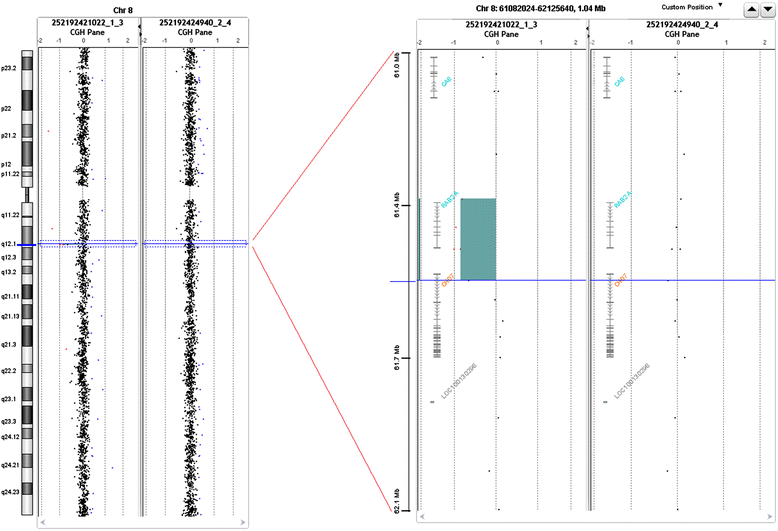CHARGE syndrome due to deletion of region upstream of CHD7 gene START codon
- PMID: 26334530
- PMCID: PMC4559162
- DOI: 10.1186/s12881-015-0225-7
CHARGE syndrome due to deletion of region upstream of CHD7 gene START codon
Abstract
Background: CHARGE syndrome is an autosomal dominant disorder, characterized by ocular Coloboma, congenital Heart defects, choanal Atresia, Retardation, Genital anomalies and Ear anomalies. Over 90 % of typical CHARGE patients are mutated in the CHD7 gene, 65 %-70 % of the cases for all typical and suspected cases combined. The gene encoding for a protein involved in chromatin organization. The mutational spectrum include nonsense, frameshift, splice site, and missense mutations. Large deletions and genomic rearrangements are rare.
Case presentation: We report here on a 5.9 years old male of Moroccan origin displaying classic clinical features of CHARGE syndrome. Using CGH array and NGS analysis we detected a microdeletion (184 kb) involving the promoter region and exon 1 of CHD7 gene and the flanking RAB2 gene.
Conclusion: The present observation suggests that deletion limited to the regulatory region of CHD7 is sufficient to cause the full blown CHARGE phenotype. Different size of deletions can result in different phenotypes, ranging from a milder to severe CHARGE syndrome; this is based on a combination of major and minor diagnostic characteristics, therefore to a more variable clinical features, likely due to the additive effect of other genetic imbalances. MLPA and CGH techniques should be considered in the diagnostic protocol of individuals with a clinical suspect of CHARGE syndrome.
Figures
Similar articles
-
The prevalence of CHD7 missense versus truncating mutations is higher in patients with Kallmann syndrome than in typical CHARGE patients.J Clin Endocrinol Metab. 2014 Oct;99(10):E2138-43. doi: 10.1210/jc.2014-2110. Epub 2014 Jul 31. J Clin Endocrinol Metab. 2014. PMID: 25077900
-
Non-homologous end joining repair mechanism-mediated deletion of CHD7 gene in a patient with typical CHARGE syndrome.Ann Lab Med. 2015 Jan;35(1):141-5. doi: 10.3343/alm.2015.35.1.141. Epub 2014 Dec 8. Ann Lab Med. 2015. PMID: 25553296 Free PMC article.
-
Revealing the function of a novel splice-site mutation of CHD7 in CHARGE syndrome.Gene. 2016 Feb 1;576(2 Pt 2):776-81. doi: 10.1016/j.gene.2015.11.006. Epub 2015 Nov 10. Gene. 2016. PMID: 26551301
-
CHD7 mutations and CHARGE syndrome: the clinical implications of an expanding phenotype.J Med Genet. 2011 May;48(5):334-42. doi: 10.1136/jmg.2010.087106. Epub 2011 Mar 4. J Med Genet. 2011. PMID: 21378379 Review.
-
8q12.1q12.3 de novo microdeletion involving the CHD7 gene in a patient without the major features of CHARGE syndrome: case report and critical review of the literature.Gene. 2013 Jan 15;513(1):209-13. doi: 10.1016/j.gene.2012.09.132. Epub 2012 Nov 7. Gene. 2013. PMID: 23142376 Review.
Cited by
-
CHARGE syndrome: genetic aspects and dental challenges, a review and case presentation.Head Face Med. 2020 May 8;16(1):10. doi: 10.1186/s13005-020-00224-4. Head Face Med. 2020. PMID: 32384900 Free PMC article. Review.
-
ALS and CHARGE syndrome: a clinical and genetic study.Acta Neurol Belg. 2018 Dec;118(4):629-635. doi: 10.1007/s13760-018-1029-2. Epub 2018 Oct 13. Acta Neurol Belg. 2018. PMID: 30317490 Free PMC article.
References
-
- Jongmans MC, Admiraal RJ, van der Donk KP, Vissers LE, Baas AF, Kapusta L, van Hagen JM, Donnai D, de Ravel TJ, Veltman JA, Geurts van Kessel A, De Vries BB, Brunner HG, Hoefsloot LH, van Ravenswaaij CM. CHARGE syndrome: the phenotypic spectrum of mutations in the CHD7 gene. J Med Genet. 2006;43:306–14. doi: 10.1136/jmg.2005.036061. - DOI - PMC - PubMed
Publication types
MeSH terms
Substances
LinkOut - more resources
Full Text Sources
Other Literature Sources


